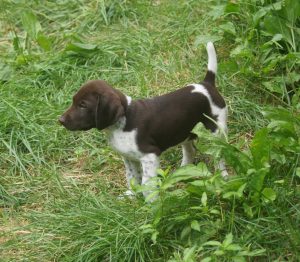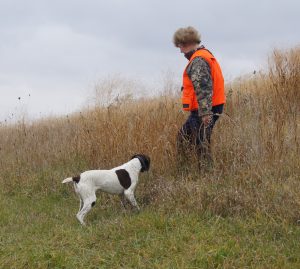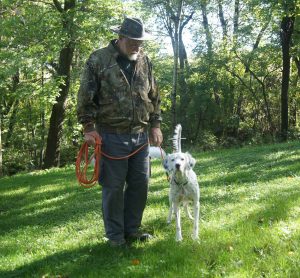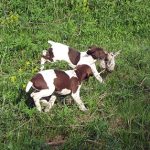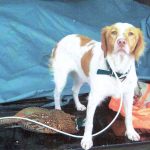The Quick Learner
Pointing Dog Pointers, February 2015
by Bob and Jody Iler
Last month we talked about the slow learner and how some of these dogs can turn out to be the best bird dogs you’ll ever own, even if they take more time to develop.
This month we’ll look at the flip side—the ‘quick learner’—the pup that comes on strong, has lots of natural ability, and is fun to train. Often this pup seems to almost train herself! Her introduction to birds is easy, she hunts with enthusiasm, points staunchly, backs other dogs, handles like a dream, and retrieves. Her gun development goes off without a hitch and she shows all the makings of a fine pointing dog. If we are describing your young dog, there’s two things we’d like to say: 1) Good for you—you’ve got yourself a gifted, quick learner, and 2) Be very careful not to push your “prodigy!”
We’ve had our share of talented young dogs at our kennel. Liz was a German Shorthair that was doing it all by the age of 7 months. Everything came naturally to her from her unique combination of great genetics. Our job was to simply bring out the ability that was already there, and to bring it out in gentle positive ways that would keep a good thing going. Liz lived a long life as a great bird dog and was the mother of two of our own superb pointing dog litter sisters—old girls now that will turn 14 the first week of March.
We had a gifted Drathaar whose owner guided for an expensive game preserve and wanted his young dog to hunt, point and retrieve for clients. This dog was to replace aChesapeakethat had retrieved hundreds of birds daily in the water and on land, and was leaving big paw prints to fill. The Drathaar was a natural on all fronts. All we supplied, again, were the elements: birds, grounds, water, and gentle training development—to bring out what was already there within him.
We could go on with more examples, but you may be thinking: These dogs have what it takes, so what’s your point?
Problem is, your young prodigy is just that: young.
What you continue to do after he’s been developed as a started dog is crucial. If you forget that you are still dealing with a young dog, you may unknowingly do things with him that will cause problems.
Has your “gifted dog” quit retrieving?
A friend had a talented young natural retriever, a German shorthair that he sold to a fellow down South. This fellow ran the new shorthair with his other dogs, English Pointers, and shot quite a few birds over the dogs each time they were out. Our friend soon got an email from the southern fellow, saying that the young shorthair had started out retrieving and had now quit. It’s pretty easy to figure out that the pup became overwhelmed: too many dogs, too many birds. Moral of the story: keep it fun, hunt your dog alone at first, and limit the retrieves. A couple quality retrieves in a session does more to imprint on the young dog than overwhelming him with birds.
Has your dog quit hunting?
Young star pupils work best with birds they’ve been properly introduced to, in cover that’s easy for them to run in, and when they are worked alone with you. If other dogs are finding the birds, this can discourage them. If there is excessive handling noise and too many guns going off, this may turn a great prospect off. If they’ve not been introduced to pheasants and get spurred, this can prove to be a bad experience that may linger in their minds. There’s a reason why your dog quits hunting: it’s up to you to figure out why and change what you’re doing. You may set yourself back in your training, but it will be worth it in the long run.
Has your dog quit pointing?
Most pups that quit pointing or go “soft” on point have been catching birds and no longer feel that they need to point. Using only spooky or wild birds that pup can’t catch will help solve this problem. Pen raised birds at game preserves should be put out spooky. Excessive use of bird traps will also cause this problem.
Does your dog crouch, or lay down on point?
Steadying a young dog to wing and/or shot before he’s had a chance to hunt at least one season can put undue pressure on the youngster and cause this problem. Don’t attempt to do this too soon. If you’ve already pushed your pup, go back to square one in your training program. Let him find, point and chase birds. Don’t try to control or reprimand him. At this stage, in order to resolve this problem, it’s even okay to let him jump in on birds once in awhile. The point here is that you want to restore pup’s confidence and sense of fun when he’s out in the field. Pressure put on a young dog too soon may make him forget that it’s supposed to be fun.
Has your dog suddenly started to notice the gun, and stopped hunting?
Your young dog never seemed to notice the gun and was completely gun-broke. Or so you thought. Now, he’s tucking his tail at the sound of the gun and perhaps quits hunting, or even runs back to you. Obviously, too many guns, dogs and other hunters definitely figure in the creation of this difficult problem. But also remember: don’t shoot at birds that your dog isn’t working or aware of. And don’t shoot more than one or two shots per bird, and more than a couple birds per session at the start. The idea is to keep that enthusiasm and natural ability connected to finding the birds with you and to the happy retrieve he’ll make after you shoot the bird. Random or multiple shooting has no place in the gun development of the young, gifted dog.
Has your dog quit handling?
One year we had a young man with a very gifted German wirehair that we trained in our started dog program. She did it all, and did it well. On the day that he came to pick her up, she showed off with a retrieve of a pheasant that was downed over the woods in our nearby field. She disappeared into the distant woods and as we held our breath, finally reappeared with the bird, bringing it all the way back to us. The day that he picked her up was also opening day for bird season. Against our advice, he was taking her hunting that same day. We didn’t hear from the fellow until January, when he called to report he was having handling problems with her. “Since when?” we asked. “Since October,” he replied sheepishly. Because he’d disregarded our advice to reacquaint himself with her and hunt alone for a good while, she’d become unruly and almost an outlaw. And he’d been afraid to call. We took her back and did some “reminder” work. Moral of this story? Again, hunt alone at first. Develop the bond and the rapport needed to be partners and don’t put your young dog in situations beyond her abilities at the start.
Remember, these points apply to the young, talented dog that seems to do it all at a young age—and may tempt us to push our star pupil much too fast and add too much pressure. Again, we risk repeating ourselves: let pups be pups. There’s a time for everything, and lessons for every season.
Pointing Dog Pointers features monthly training tips by Bob and Jody Iler, who own Green Valley Kennels in Dubuque, Iowa. Bob and Jody have trained pointing dogs for over 35 years and have written many articles for The Pointing Dog Journal.



